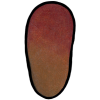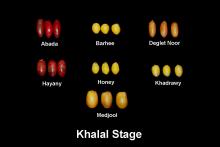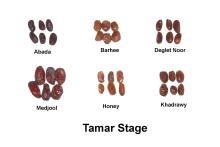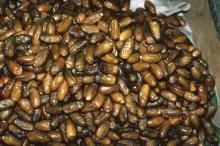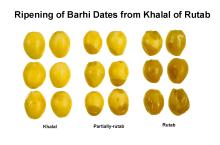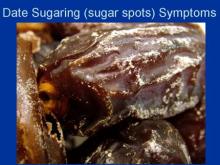Maturity and Quality
A small quantity of dates is harvested at the "Khalal" stage (partially-ripe) when they are yellow or red (depending on cultivar), but many consumers find them astringent (high tannin content). Most dates are harvested at the fully-ripe "Rutab" and "Tamar" stages, when they have much greater levels of sugars, lower moisture and tannin content, and softer than the "Khalal" stage dates.
- Fruit size, color, texture, cleanliness
- Freedom from defects (such as sunburn, insect damage, sugar migration to fruit surface, and fermentation) and decay-causing pathogens
- Sweetness: Sucrose is the main sugar in some cultivars while reducing sugars are predominant in others; total sugars represent about 50% (fresh wt basis) or 75% (dry wt basis)
Postharvest Handling and Storage
0°C (32°F) for 6-12 months
Depending on cultivar (semi-soft dates, such as "Deglet Noor" and Halawy", have longer storage-life than soft dates, such as "Medjool" and "Barhi"). -18°C (0°F) for longer storage durations.
Freezing temperature is -15.7°C (3.7°F).
<25ml/kg·hr for "Khalal" stage dates
<5ml/kg·hr for "Rutab" and "Tamar" stage dates kept at 20°C (68°F).
The respiration rates increase with higher moisture content.
To calculate heat production, multiply ml CO2/kg·hr by 440 to get BTU/ton/day or by 122 to get kcal/metric ton /day.
We found no effect of exposing Khalal stage, yellow Barhee dates to 100ppm ethylene for up to 48 hours at 20°C (68°F) and 85-90% relative humidity. However, Khalal stage dates may respond to ethylene action at higher temperatures of 30-35°C (86-95°F), which are more optimal for their ripening. Rutab and tamar stage dates are not influenced by exposure to ethylene but can readily absorb the aroma of other products. Thus, dates should not be stored with garlic, onion, potato, or other commodities with strong odor.
70-75%
At higher relative humidities, dates will absorb moisture from the room air unless they are packaged in moisture-proof containers.
Packaging of “Tamar” dates in nitrogen (to exclude oxygen) reduces darkening of dates and prevents insect infestation. Yellow “Khalal” Barhee dates can be stored in 20% carbon dioxide-enriched air at 0°C (32°F) and 90-95% relative humidity for up to 26 weeks as compared to 7 weeks for air-stored dates. The elevated carbon dioxide concentration is fungistatic (inhibits growth of fungi, but once the dates are transferred to air, the fungal growth will resume, especially under higher temperatures). Thus, it is important to market the CA-stored dates soon after removal from storage.
Disorders
Darkening. Both enzymatic and non-enzymatic browning occur in dates and increase with higher moisture content and higher temperatures. Enzymatic brown ing can be inhibited at low oxygen concentrations.
Souring. Yeasty fermentation results in souring of dates with moisture content above 25%.
Sugar Spotting. Crystallization of sugars below the skin and in the flesh of soft date cultivars. Although it does not influence taste it alters fruit texture and appearance. Storage at recommended temperatures minimizes this disorder, which occurs mainly in cultivars in which glucose and fructose are the main sugars.
Microbial spoilage can be caused by yeasts (most important), molds and bacteria. Yeast species of Zygosaccharomyces are more tolerant of high sugar content than others found in dates. Yeast-infected dates develop an alcoholic odor (become fermented). Acetobacter bacteria may convert the alcohol into acetic acid (vinegar). Fungi (Aspergillus, Alternaria, and Penicillium spp) may grow on high-moisture dates, especially when harvested following rain or high humidity period.
Control Strategies
- Dry the dates to 20% moisture or lower to greatly reduce the incidence of molds and yeasts
- Maintain recommended temperature and relative humidity ranges throughout the handling system
- Avoid temperature fluctuations to prevent moisture condensation on dates, which may encourage the growth of decay-causing microorganisms
- Use adequate sanitation procedures in the packinghouse and storage rooms
Insect Infestations
- Dates can be infested with some of the stored-products insects and must be fumigated with an approved fumigant for disinfestation followed by packaging in insect-proof containers
- "Organic" dates may be treated with 100% carbon dioxide for 1-2 days since chemical fumigants (such as methyl bromide) cannot be used
- Storage below 13°C (55°F) will prevent insect feeding damage and reproduction
- Storage at 5°C (41°F) or below will control insect infestation
[Link to "Harvesting and Postharvest Handling of Dates" by Adel A. Kader, and Awad M. Hussein. ICARDA, Aleppo, Syria. 15 pp. (2009)]



